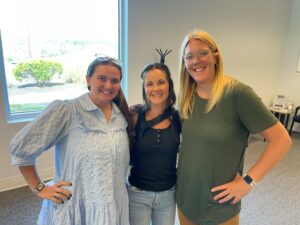By, Allison R. Weder
In 2020, Joanna Dennstaedt fell and seriously injured her shoulder. She saw a doctor right away, but before she could get an MRI to further evaluate the injury, the world shut down. Joanna remembers how the COVID Pandemic delayed her recovery. “My MRI was put off nine months. The pain of the injury had worn off and I got a little better. But when I finally got the MRI it showed I had a torn labrum and I needed surgery. I thought, when am I going to have time for that? I put it off and put it off.” Joanna tried to live her life like she wanted, doing the activities she loved to do. She participated in CrossFit and regularly went to the gym for the exercise she craved and needed, physically and emtionally. Eventually, the pain held her back and she knew the surgery needed to be done.
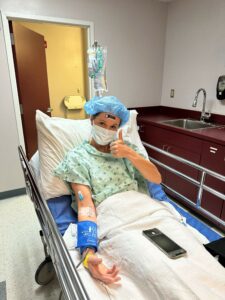 Joanna is no stranger to injuries, surgeries, and rehabilitation. “I have had multiple knee surgeries from sports in college. I went through cancer, which included surgery and cancer treatment eight years ago. So, when the doctor said this is going to be painful; this is going to be rough, I was like, I’ve been through a lot, I’ll be ok.” But the repair was not at all what she expected. “It was a grade four tear. I had several anchors put in around my whole entire capsule coming out with a 270-degree repair. I had a Bankart and a slap tear, and then a medial tear across my whole labrum. It was terrible and the surgery was terrible.”
Joanna is no stranger to injuries, surgeries, and rehabilitation. “I have had multiple knee surgeries from sports in college. I went through cancer, which included surgery and cancer treatment eight years ago. So, when the doctor said this is going to be painful; this is going to be rough, I was like, I’ve been through a lot, I’ll be ok.” But the repair was not at all what she expected. “It was a grade four tear. I had several anchors put in around my whole entire capsule coming out with a 270-degree repair. I had a Bankart and a slap tear, and then a medial tear across my whole labrum. It was terrible and the surgery was terrible.”
Joanna had a long road to recovery ahead of her, but she was ready. “I didn’t want this to put me down. I was really motivated to get back to CrossFit and to working out.” Joanna needed to wear an immobilizer for ten weeks following surgery. “It’s a “Catch 22.” The longer you immobilize, the more work you’ll have to do later, but I needed a longer immobilization for the amount of healing that needed to take place. After the 10 weeks of healing as soon as I came out of the brace I started physical therapy to work on range of motion, pain relief, and strength.”
Joanna started a long adventure with physical therapy after surgery. “I went to a place my doctor had referred me to. I went a couple times, but I felt in that place I was not going to make the strides I wanted. I wanted someone who was going to be hands-on. I wanted someone who was going to really motivate me. I wanted to be held accountable. I wanted to be pushed.” Joanna knew she needed to be proactive and stay in control of her situation. She decided to find a clinic that better suited her needs. Joanna heard a new Phoenix Physical Therapy clinic was opening in Mechanicsburg, Pennsylvania. The Clinic Director, Kelly Clancy, PT, DPT is a Messiah University alumnus and so is Joanna. “I didn’t know Kelly personally, but we overlapped as friends when we were students at Messiah. When I heard she was there, I thought I should give it a try.”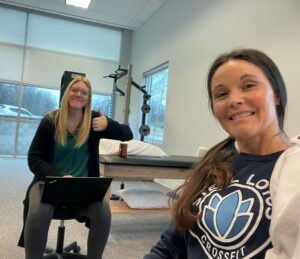
Joanna immediately knew the Phoenix PT clinic was different. When she walked in, she noticed several comforting details. “I liked that it was new, clean, and maintained. Staff was friendly and Kelly was motivated to get me better. And Kelly told me right away, ‘We are going to do this together.’ Through blood, sweat and tears, I felt like she was committed to my healing. That’s what I needed. That’s what I was looking for. I feel that’s what everyone should be looking for.”
Comfortable and confident she was in the right place now, Joanna knew her therapy journey could finally begin. “In the beginning, it was just really small muscle movements, small techniques to gain strength and range of motion. I would do a few little exercises and then Kelly would spend a lot of hours with me stretching that capsule. She got to know me and how much I could take. She would push me to my limits.” Joanna would use an arm bicycle, heat, ice and a transcutaneous electrical nerve stimulation, or TENS, machine. A TENS machine delivers small electric impulses to the injured area which can help relieve pain and relax muscles. “As (my therapy) progressed, I was there three times a week, an hour and a half each time. So, we kept adding things as healing progressed. We took some steps back, too. Often, there were some weeks where we were going backwards. One step forward, two steps back. I needed to have an open mind about that. Slow and steady wins the race.”
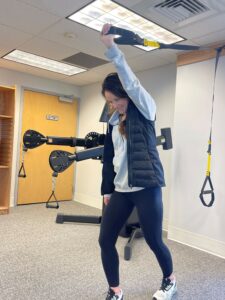 Joanna’s doctor told her to expect a full recovery to take up to 12 months. “I worked hard, hard, hard, for about six months. Then, I felt like I hit a plateau. I told Kelly, ‘I think this is it.’ But she was so encouraging, she didn’t let me quit. She would say, ‘I’ll see you tomorrow,’ like it wasn’t an option not to come.” Joanna was grateful for the encouragement and Kelly’s expert knowledge. “That’s why it is important to have a place with high quality therapists. (Kelly) knows where you need to be and where you want to be. She knew I had a long way to go and knew my goals. (She was) not just treating a patient because it’s her job. She actually cares about me getting back to where I want to be.”
Joanna’s doctor told her to expect a full recovery to take up to 12 months. “I worked hard, hard, hard, for about six months. Then, I felt like I hit a plateau. I told Kelly, ‘I think this is it.’ But she was so encouraging, she didn’t let me quit. She would say, ‘I’ll see you tomorrow,’ like it wasn’t an option not to come.” Joanna was grateful for the encouragement and Kelly’s expert knowledge. “That’s why it is important to have a place with high quality therapists. (Kelly) knows where you need to be and where you want to be. She knew I had a long way to go and knew my goals. (She was) not just treating a patient because it’s her job. She actually cares about me getting back to where I want to be.”
Around eight months into her recovery, Joanna noticed real progress when she carefully returned to some normal activities. “I would go to the gym one day a week and the rest of the time I would go to PT. I would see the translation. I was starting to get back to doing what I want to do, but I still had Phoenix alongside.” Joanna’s sessions continued for several more weeks. While Kelly held her accountable, Joanna pushed herself. Kelly is proud of their teamwork. “Joanna was an absolute pleasure to treat. She had one of the most significant shoulder repairs I’ve seen in my career, and it was awesome to have the chance to work together to return her back to some pretty ambitious goals. Jo is not someone who likes to hear “no” or “you can’t do that,” so it was a challenge, daily, to find things that kept her engaged and invested in her rehab, but also stayed within the safety of her post-surgical protocol restrictions. It is incredibly rewarding to work with patient’s like Jo and see them get back to the activities that they love.”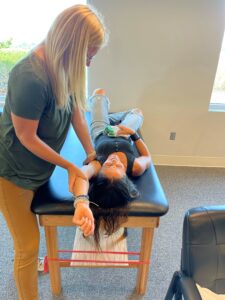
Joanna is relieved she is able to be active again. “I’m back in the gym and I’m doing most everything. I still have healing, let’s be honest. I’m in my 40’s. There are some limitations that naturally start to happen that I need to be content with as well. But at the end of the day, I do love that I have in my back pocket, a place that I know is loving and supportive for physical healing. I’m a very active person for my mental and physical health. I have an exhausting, draining day job, and movement has always been important to me as long as I can remember. It is my goal to be able to stay strong and healthy to take care of my organization and my family.”
Joanna’s daughter is now attending therapy at Phoenix Physical Therapy – Mechanicsburg for a pulled hamstring. Kelly was the first person she thought of, “because of that trust. These people are my friends for life now. After you walk through a season like that, and people come alongside you in your trauma and healing and help you, you build a really close relationship with those people.”
Joanna shares a final thought about her experience. “I always tell people to find the right place even if it takes a few tries. I felt like Kelly was going to be on my team. She was going to help me heal and we were going to do this together. I wasn’t just another number. That is her approach to medicine and Phoenix’s approach to patient care.”